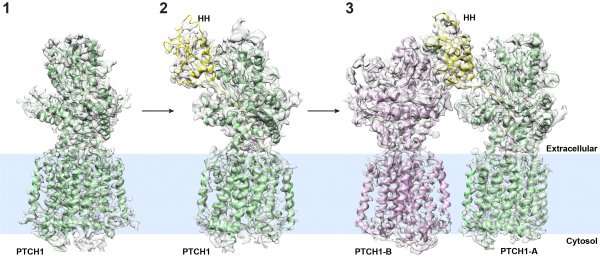Cryo-EM structures illuminate the molecular mechanism of Hedgehog signaling. 1. PTCH1 alone. 2. 1-to-1 ratio PTCH1-HH complex (Nature 560:128-132). 3. 2-to-1 ratio PTCH1-HH complex. Credit: Science
In a study published today in Science, UT Southwestern and Rockefeller University researchers used advanced microscopes to determine at atomic resolution the structure of a molecular complex implicated in birth defects and several cancers.
The Hedgehog signaling pathway, which transmits information to embryonic cells, is crucial to human health. Insufficient signaling during development leads to birth defects, while unrestrained Hedgehog signaling occurs in many cancers. Excessive signaling is implicated in basal cell carcinoma – the most common malignant cancer in humans – as well as in brain cancer, breast cancer, and prostate cancer, said Dr. Xiaochun Li, UT Southwestern Assistant Professor of Molecular Genetics and Biophysics and a Rita C. and William P. Clements, Jr. Scholar in Biomedical Research. Many pharmaceutical companies are developing drugs that target Hedgehog signaling. Having a clearer view of the structure could help those efforts, Dr. Li said.
The researchers, using cryo-electron microscopy (cryo-EM) technology, showed that two Patched-1 (PTCH1) molecules simultaneously engage a single Hedgehog (HH) molecule, but at two distinct sites. This unique 2-to-1 ratio PTCH1-HH complex is required for efficient Hedgehog signaling in cells.
Cryo-EM uses enormous microscopes equipped with robotics to determine the structure of molecular samples that are frozen at temperatures so low that ice crystals cannot form.
In another paper published in Nature last month, Dr. Li's group reported a cryo-EM structure of the 1-to-1 PTCH1-HH complex. Their biochemical assays indicated that HH binding to one PTCH1 molecule may not be sufficient for full activity. HH may need to recruit either a different protein or another PTCH1 molecule, he said.
"In the current Science paper, we report a 2-to-1 PTCH1-HH complex in which one Hedgehog molecule binds to two of its receptors (PTCH1) at two different spots. We used our cell biology assay to verify that this 2-to-1 complex is indeed the signaling generator for Hedgehog signaling. Combined with the earlier study published in Nature, we hope our new work will provide additional insights for physicians and scientists in this field," he explained.
More information: Xiaofeng Qi et al. Structures of human Patched and its complex with native palmitoylated sonic hedgehog, Nature (2018). DOI: 10.1038/s41586-018-0308-7
Xiaofeng Qi et al. Two Patched molecules engage distinct sites on Hedgehog yielding a signaling-competent complex, Science (2018). DOI: 10.1126/science.aas8843
Provided by UT Southwestern Medical Center





















